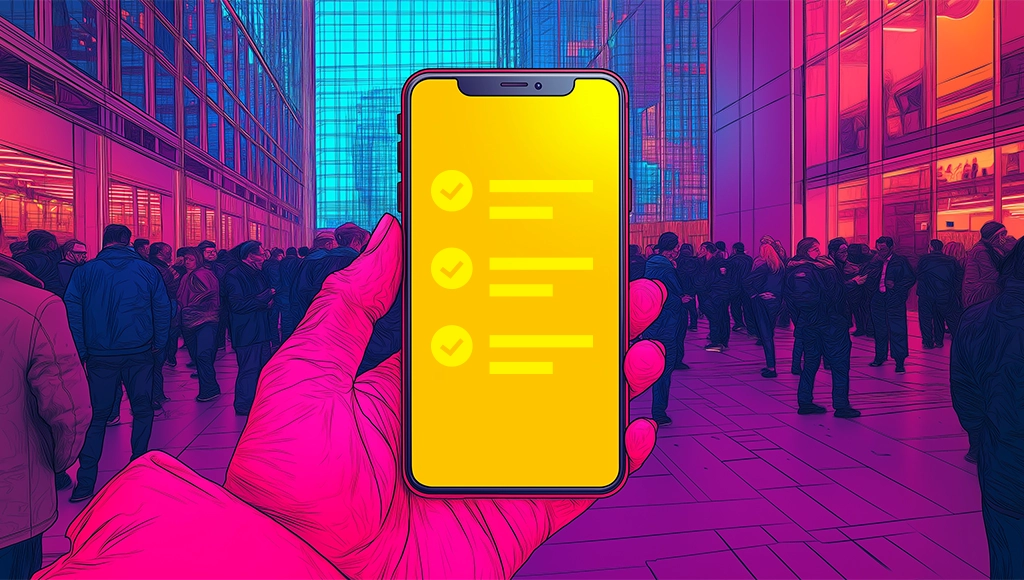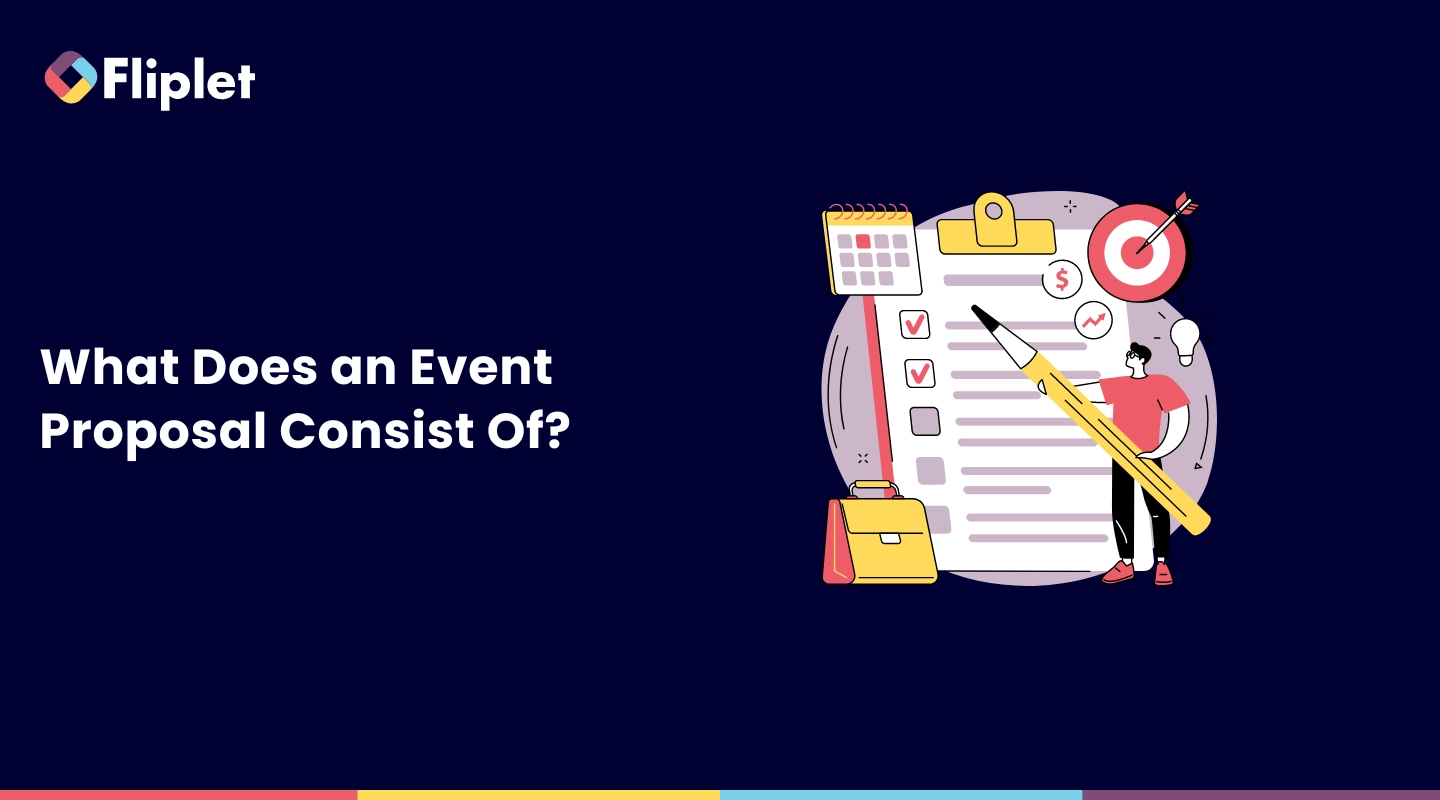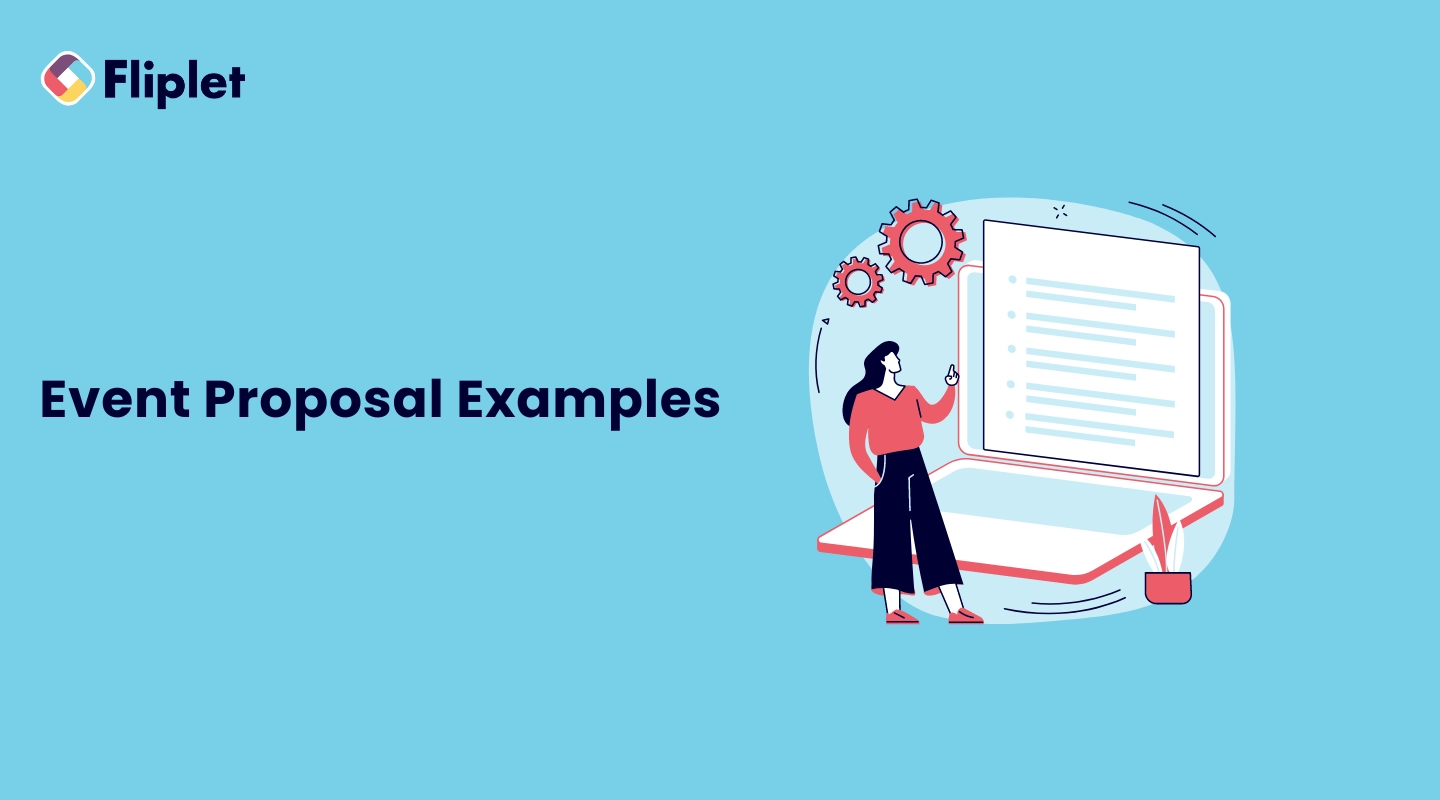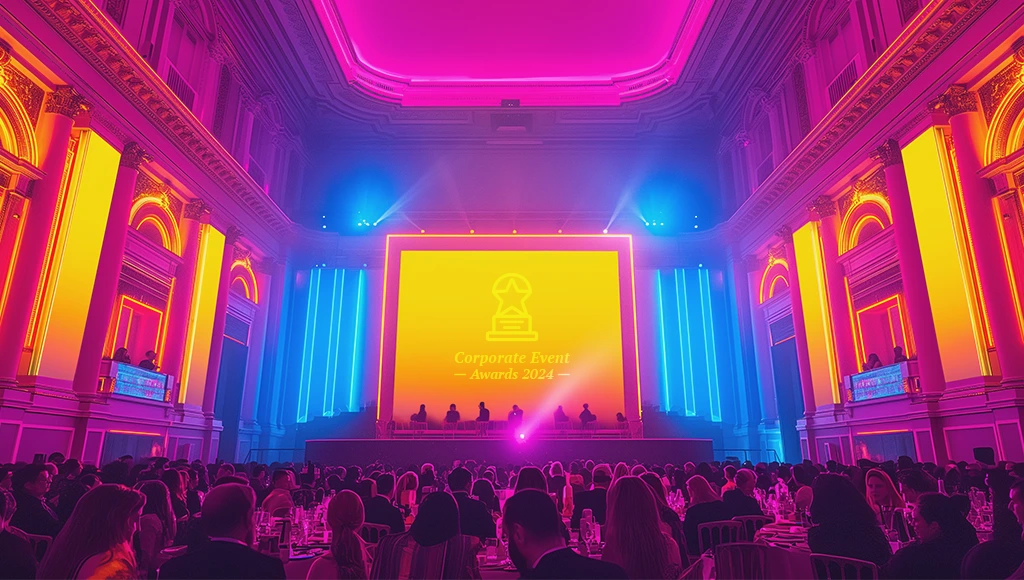How to Create an Event Proposal: 10 Important Things to Know

Lisa Broom | Head of Marketing

If you can really nail an event proposal, you can unlock so much potential in your career — securing more clients and setting your events up for success.
That’s because your event proposal serves as a detailed plan for both you and your clients. It outlines the event’s objectives, logistics, and expected outcomes, convincing potential clients of your capability to deliver a memorable experience.
In this guide, we’ll walk you through the key elements of crafting a winning event proposal that stands out. (We even have event proposal examples!)
Key Takeaways
- Understanding what an event proposal is and its importance
- Essential tips for crafting an effective event proposal
- Key components to include in your event proposal
- How to make your proposal more attractive using design and technology
- Real-life examples and templates for event proposals
What Is an Event Proposal?
An event proposal (or event management proposal) is a comprehensive document that outlines the details of an event, including its purpose, logistics, budget, and marketing plan. It is used to pitch the event concept to clients or stakeholders, demonstrating your expertise and vision. Reviewing event proposal examples can help you understand best practices and key elements to include.
In a recent discussion at Quora, users highlighted some of the things they look for in an event proposal. These included:
- Event Overview: A summary of the event, including its purpose and goals.
- Target Audience: Detailed information about who the event is intended for.
- Event Schedule: A timeline outlining key milestones and activities.
- Venue Details: Information about the location, including amenities and layout.
- Budget: A comprehensive budget breakdown covering all costs.
- Marketing Plan: Strategies for promoting the event to the target audience.
- Sponsorship Opportunities: Details on sponsorship packages and benefits.
- Team and Roles: An overview of the event team and their responsibilities.
- Contingency Plans: Plans for handling potential issues or emergencies.
By including these elements, you can create a thorough and effective event proposal that clearly communicates your vision and plan for the event.
Important Event Planning Proposal Tips for Businesses
Crafting an effective event planning proposal involves several key steps:
- Talk to Your Client About Their Needs: Understand their goals and expectations.
- Highlight Your Experience and Expertise: Showcase your successful past events.
- Share Event Overviews and Plans: Provide a detailed plan of the event.
- List Your Services Clearly: Specify what services you offer.
- Preview Your Proposal and Review Together: Go through the proposal with your client to ensure it meets their needs.
Looking for still more tips?
This video by Event Certificate recommends her 5 P’s:
- People: Include info on the people in your team that will help with the event.
- Process: Let your client know what your process is like. That way, the client knows what to expect when working with you.
- Packages: Outline everything your client needs and bundle these services in packages.
- Pricing: Include the price of your packages in your proposal — this will make it easier for your clients and build trust.
- Policies: Include how you do business, including dates the client will need to respond to your proposal.
What Does an Event Proposal Consist Of?

If you are wondering how to make a proposal for event, you need to know what exactly goes into one.
A successful event proposal is a detailed document that encompasses various critical elements. Each component communicates the event’s vision, logistics, and value to potential clients and stakeholders.
(Helpful hint: Remember, a lot of the work you find here is now being taken over by artificial intelligence. Our AI event app offers a popular solution that can rapidly creates an event planning proposal.)
Here’s an expanded look at what a comprehensive event proposal should include:
Turning an Event Planning Proposal into a Business Proposal
- Define Objectives and Goals: Clearly state what you aim to achieve with the event (e.g., brand awareness, lead generation).
- Foundation of Proposal: Use these objectives to guide all planning and decision-making processes.
Clearly defining your objectives and goals is the cornerstone of any event planning business proposal. This section should articulate what you aim to achieve with the event, such as increasing brand awareness, generating leads, or fostering community engagement.
These clearly stated objectives form the foundation of your proposal and guide all subsequent planning and decision-making processes.
Identifying Your Target Audience
- Demographic Information: Include details such as age, gender, occupation, and interests.
- Tailored Experience: Design content and activities to appeal directly to the audience’s preferences.
Understanding your target audience is crucial for tailoring the event experience to meet their needs and expectations. Provide detailed demographic information, such as age, gender, occupation, and interests, to ensure your event resonates with the right people.
This helps in designing content, activities, and marketing strategies that appeal directly to your audience, thereby enhancing engagement and satisfaction.
Creating a Detailed Timeline
- Planning Phases: Outline key planning stages and deadlines.
- Marketing Activities: Schedule promotional efforts.
- Event Day Schedule: Provide a detailed schedule of the event day’s activities.
A detailed timeline outlines all the key milestones and deadlines leading up to the event. This should include planning phases, marketing activities, booking deadlines, and the event day schedule.
A well-structured timeline helps keep the event on track, ensures that all tasks are completed on time, and allows for adequate preparation for each stage of the event.
Selecting the Perfect Location
- Venue Options: Detail potential venues, including capacities and amenities.
- Accessibility and Convenience: Highlight factors like attendee convenience and venue accessibility.
- Logistical Considerations: Address technical and logistical needs.
Choosing a venue that aligns with the event’s objectives and is convenient for attendees is vital. This section should detail the venue options, including their capacities, amenities, accessibility, and any logistical considerations.
Highlight why the selected location is ideal for your event, taking into account factors like attendee convenience, ambiance, and technical requirements.
Designing the Event Format
- Session Types: Define the types of sessions (e.g., keynotes, workshops, panels).
- Activity Flow: Outline the sequence and duration of activities.
- Engagement Opportunities: Include networking and interactive opportunities.
The event format is the structure of the event, including sessions, activities, and networking opportunities. Clearly outline the types of sessions (keynotes, workshops, panels), their durations, and the flow of activities throughout the day.
This helps in creating a coherent and engaging program that keeps attendees interested and involved.
Developing a Marketing and Publicity Plan
- Marketing Strategies: Detail digital marketing, social media, email campaigns, and PR efforts.
- Tools and Apps: Use Fliplet’s marketing app to enhance marketing efforts.
- Promotion Plan: Create a comprehensive strategy to attract attendees.
A comprehensive marketing and publicity plan is essential to promote the event and attract attendees. Detail your strategies for advertising the event, including digital marketing, social media campaigns, email marketing, and public relations efforts.
Consider using Fliplet’s marketing app to streamline and enhance your marketing activities, ensuring a broad reach and effective communication.
Budget Planning
- Cost Breakdown: Categorize costs (venue, catering, marketing, technology, staffing).
- Estimates and Actuals: Provide estimated and actual costs for transparency.
- Financial Management: Ensure detailed financial planning to manage expenses and avoid surprises.
Providing a detailed budget that covers all aspects of the event ensures transparency and accuracy. Break down costs into categories such as venue, catering, marketing, technology, and staffing. Include estimates and actual costs to give a clear financial picture.
A thorough budget plan helps in securing approvals, managing expenses, and avoiding any financial surprises.
Free Event Proposal Template

Using a free event proposal template can save time and ensure you include all necessary details. Here’s a sample event proposal to get you started.
How to Make an Event Proposal More Attractive?
Crafting an appealing event proposal involves more than just presenting information. It’s about engaging the client and clearly demonstrating the value of your event. Here’s how to make your event proposal stand out:
Think About the Design
Create a Compelling Visual Narrative
- Use visuals to tell the story of your event.
- Incorporate graphics, images, and charts to illustrate key points.
Integrate the Client’s Branding Elements
- Personalize the proposal by including the client’s logos, colors, and branding.
- Align the proposal’s aesthetic with the client’s brand identity to make it feel relevant.
Include Interactive Content to Enhance Engagement
- Utilize videos, links, and other interactive elements to keep the client engaged.
- Embed multimedia content that can provide a dynamic experience and highlight important aspects of the proposal.
Propose Modern Technology Solutions for your Event
Leveraging modern technology can greatly enhance the attendee engagement, lead generation, and other key performance indicators for your event. That’s why using tools like Fliplet’s events app builder can help create a dynamic and interactive tool that forms a key part of your proposal. Here’s how:
Leverage Tools and Examples
- Use Fliplet’s app builder to create a lead scanner.
- Create ways for attendees to engage during an event.
- Make a plan for using digital tools to follow up with attendees after the event.
Demonstrate Clear Value
Clearly outline the benefits and value that your event will bring to the client and attendees. Highlighting these points can make a compelling case for why your event is the best choice:
Highlight Benefits
- Detail the specific advantages and positive outcomes of the event.
- Show how the event will meet the client’s objectives and exceed their expectations.
Showcase ROI
- Provide projections or past examples of successful events to illustrate potential returns.
- Include metrics or KPIs to back up your claims about the event’s impact.
Use Testimonials and Case Studies
Building trust and credibility is crucial. Testimonials and case studies from previous events can effectively demonstrate your capability and reliability:
Include Testimonials
- Add quotes from satisfied clients who have previously worked with you.
- Use testimonials to highlight your strengths and successes.
Showcase Case Studies
- Present detailed case studies of past events that showcase your planning and execution skills.
- Use these case studies to provide concrete evidence of your ability to deliver successful events.
By focusing on design, utilizing modern technology, demonstrating clear value, and including testimonials and case studies, you can create an event proposal that not only informs but also impresses and engages potential clients.
Event Proposal Examples

We should position it as that they should include tech in their proposal because tech can clearly benefit the event by increasing attendee engagement etc.
Reviewing successful event proposal examples can provide inspiration and insights into effective proposal writing. It’s also a great way to bring all the ideas we’ve mentioned above together in one place. This is a great way to learn how to draft a proposal for an event. Here is an example to consider:
Event Overview
Event Name: Connect & Collaborate Business Networking Event
Event Date: October 15, 2024
Event Location: Downtown Conference Center, City, State
Objectives and Goals
- Facilitate meaningful connections among business professionals
- Provide a platform for sharing insights and experiences
- Promote collaboration and partnerships among attendees
- Enhance brand visibility and credibility for sponsors and participants
Identifying Your Target Audience
- Primary Audience: Small to mid-sized business owners, entrepreneurs, and professionals from various industries
- Secondary Audience: Investors, corporate executives, and industry experts
Creating a Detailed Timeline
- 3 Months Before the Event:
- Finalize event concept and objectives
- Secure venue and date
- Begin marketing and publicity efforts
- 2 Months Before the Event:
- Confirm speakers and special guests
- Finalize event schedule and sessions
- Continue marketing and promotion
- 1 Month Before the Event:
- Confirm attendee registrations
- Finalize all logistical arrangements
- Prepare event materials and signage
- Event Day:
- Setup and registration
- Conduct sessions and networking activities
- Post-event feedback collection
Selecting the Perfect Location
- Venue: Downtown Conference Center
- Capacity: 300 attendees
- Amenities: AV equipment, Wi-Fi, catering services, breakout rooms
Designing the Event Format
- Morning Session: Keynote speeches and panel discussions
- Afternoon Session: Workshops and breakout sessions
- Evening Session: Networking cocktail reception
Developing a Marketing and Publicity Plan
- Digital Marketing: Utilize social media platforms, email campaigns, and SEO strategies to promote the event
- Public Relations: Distribute press releases and collaborate with industry influencers
- Event App: Use Fliplet’s marketing app to streamline marketing efforts and enhance attendee engagement
Budget Planning
- Venue Rental: $5,000
- Catering: $4,000
- Marketing and Promotion: $2,000
- Speaker Fees: $3,000
- Event Materials: $1,500
- Contingency: $1,000
- Total Budget: $16,500
Make Connections and Better Your Event Proposals with Fliplet
With the right event management proposal, you can make anything happen!
Including technology in your proposal can significantly enhance your event by increasing attendee engagement, streamlining operations, and providing valuable insights.
Using Fliplet’s event networking app can help you gather feedback and insights from industry peers, refining your ideas and strategies. This not only strengthens your event proposal but also ensures you deliver a memorable and impactful experience.
Embrace the future of event technology with Fliplet, the best event technology tool for 2024, and make your events a resounding success.
Reach out to our team today for a free call!
FAQs
What makes a good event proposal?
A good event proposal clearly outlines the event’s objectives, logistics, budget, and marketing plan, demonstrating value and feasibility.
How to make a proposal for events as a small business owner?
Focus on your unique selling points, understand your client’s needs, and provide a detailed plan with a clear budget.
How detailed should the budget section be in a business event proposal to ensure transparency and approval?
The budget section should be as detailed as possible, including all anticipated costs to ensure transparency and build trust.
What is the significance of branding in a corporate event proposal?
Branding ensures the proposal aligns with the client’s identity, making it more relevant and appealing.
How can I incorporate feedback from previous corporate events into my new event proposal to enhance its effectiveness?
Use feedback to highlight past successes and areas of improvement, showing your ability to learn and adapt.
How to draft a proposal for an event in a month?
Start with a template, clearly outline your objectives, and focus on critical details such as budget, timeline, and marketing plan to expedite the process.




